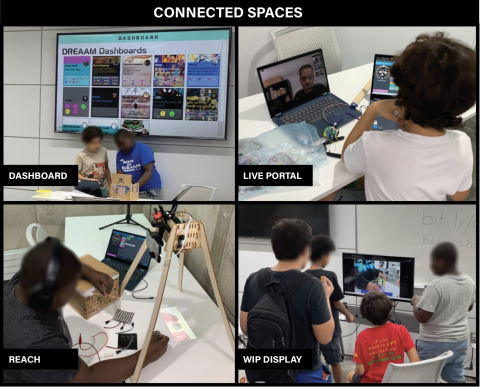Body
Image

Connected Spaces: A Technological Framework for Fostering Collaboration by Linking Novice Makers with Mentors and Peers
The Connected Spaces (C/S) project consists of a technological toolkit and design framework to connect geographically distributed communities of middle and highschool makers to promote collaboration between peers and facilitate mentorship and technical assistance. The toolkit consists of a suite of four technologies. First, the Dashboard, an ambient profile display for students to showcase their interests as well as evolving skills and affinities across makerspaces to support help seeking among makers. Second, the Live Portal, an always on video conference room connecting several makerspaces running activities simultaneously. Third, the Remote Embodiment for Augmented Collaborative Help (REACH), a novel communication technology consisting of two devices installed in different spaces that simultaneously project and capture a designated work area allowing distanced collaborative design and debugging around physical objects. And fourth, the Work-in-Progress (WIP) Display for students to share their evolving work with their peers. To iterate and refine the design of these technologies and test the theoretical assumptions behind them, we are running summer maker workshops for local community groups of middle schools. The extended community of practice offered by the C/S framework aims to support students in connecting STEAM competences with their personal interests and evolving identities as they experience the possibilities offered by STEM career pathways.
Pillar 1: Innovative Use of Technologies in Learning and Teaching
Effective learning environments that invite young people make—to design, debug, and fabricate—artifacts to address personally meaningful problems also include opportunities to engage in core STEM+C practices of collaboration, building on the knowledge of others, mentorship, and the use of digital tools. The C/S suite of technologies specializes in supporting the development of these skills to enable distributed knowledge construction and community building across distances.
Pillar 2: Partnerships for Career and Workforce Preparation.
The C/S project is working with three community organizations to reach students underrepresented in STEM careers. DREAAM works with young black males, The Well with young black females, and the Beam Center who partners with NYCPS Summer Rising program benefiting immigrants. The C/S camps have focused on providing awareness of career opportunities in the technological and computational fields. For this summer, the expectation is to also recruit repeating participants as mentors for this summer implementation.
Pillar 3: Strategies for Equity in STEM Education
Studies have shown that informal makerspaces that include learners and mentors from a wide range of backgrounds appeal more broadly to young women and students of color (Desportes et al. 2022). The C/S is designed to support remote collaboration and connect learners who are underrepresented in STEM with peers and mentors. By providing an extensive community of practice, these learners will have access to support beyond their possibly limited cohorts and will begin to develop personal paths within STEM+C fields.

Discipline(s)
Computer and informational technology science
Engineering
Target Gradespan(s)
Middle school (6-8)
High school (9-12)
Target Participant(s)
Youth / students
Project Setting(s)
Informal Education
Category
Developing and Testing Innovations (DTI)